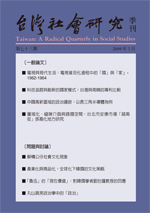
《台灣社會研究季刊》 第73期:

一般論文
電視與現代生活:電視普及化過程中的「國」與「家」,1962-1964/柯裕棻(73 民 98.03 頁 01-38)
本篇論文探討從1962年開始至1964年之間電視機在台灣社會初期的發展狀況,從電視科技的國家決策、電視機的銷售、以及日常生活脈絡等幾方面檢視電視機的生產與消費。本研究也從電視機進入日常生活的社會意涵中探討「家」與「國」的交互作用。本研究認為,電視機在普及化初期引發了強勢的國家理性與日常生活之間的張力,並使家與國展開新的協商過程。
關鍵字:電視、冷戰時期、現代生活
Focusing on the national policy of production, promotional strategy of merchandisers, and consumption in everyday life contexts, this research explores the installation process of television in Taiwan's society, from 1962 to 1964. This research specifically discusses the political and pedagogical aspect of “nation” that has been initiated and extended by the introduction of television into familial space. The tension between the state and the family has been transformed and re-negotiated within and without the television.
Keywords:television, Cold War Era, modern life
科技追趕與創新的國家模式:台灣與南韓的專利比較/王振寰、蔡青蓉(73 民 98.03 頁 39-76)
本文討論台灣與南韓在科技創新上的差異,並以兩國在美國登記的專利資料,來分析台灣與南韓在創新上的表現。本文發現這二國家從1990年代之後,都展現了高度的創新能力,在專利數的獲取上,甚至超過傳統先進國家。但是二國也在專利項目和獲取模式上表現了很大的差異:台灣的個人和中小企業佔很高的比例,而南韓則是以大型財閥為主;電子電機類在台灣與南韓都佔所有六大類別中的第一位,但是南韓的專利高度集中在該項產業,而台灣則是較為分散,傳統的機械業也在專利的獲取上佔有重要地位。這樣的差異,主要源自二國科技追趕的體制,台灣的體制過去是以中小企業而南韓則是以大財閥為主的體制。這樣的追趕體制也塑造了二國在邁向創新過程時,所展現的不同途徑—南韓傾向大企業領導的模式,而台灣則是大型企業與中小企業共存的網絡式聚集經濟。
關鍵字:台灣、南韓、創新、專利、追趕
This paper discusses different patterns of innovation, and their institutional paths in Taiwan and South Korea. By using the USPTO patent data as indicators of innovation, this paper finds that both Taiwan and South Korea have progressed rapidly in terms technological innovation since the 1990s, overtaking many of the advanced countries. Nevertheless, there are major differences in the patenting behavior: while individuals and small and medium sized enterprises (SMEs) comprised of a large part of patents in Taiwan, the chaebols are the major contributors of South Korea's patents. Moreover, although electrics and electronics are the sectors that gain most of the patents in both countries, Taiwan's patents are more dispersed into other sectors while South Korean counterparts are heavily concentrated in the electronics sector alone. These differences, this paper argues, come mainly from the institutional roots of their economic catching up era in which Taiwan was based on a SMEs-dominant industrial structure while the South Korean was the Chaebol-based, instead. This paper further argues that the institutional roots have largely shaped both countries’ diverse roads toward innovation-based economy: the South Korean case is transitioning toward a scale-based model where big firms are the major actors of innovation; while the Taiwanese one is transforming toward a densely networked cluster model in which both big firms and SMEs are major actors.
keywords:Taiwan, South Korea, innovation, patent, catch up
中國高新區域的政治鑲嵌:以長三角半導體為例/范淑敏、周志龍(73 民 98.03 頁 77-118)
本文的目的在於研究中國高新區域的政治鑲嵌究竟如何形成與如何運作?政治鑲嵌的關係、方式與內容不同,又會如何影響和制約政府和焦點廠商所進行的策略選擇?以長三角的半導體產業作為分析對象,著重於中國政府(中央和地方政府)和長三角重要的晶圓廠的政治鑲嵌之研究。本文實證發現,在中國高新區域的政治鑲嵌是隨著時間性的不同,在內容亦有所不同,但卻無法支持Guthrie(1998)所指稱的「當中國市場經濟愈發達或法令愈完備時,關係(guanxi)的重要性會下降」或如陳東升(2001)的研究,認為台積電在創建初期,政治鑲嵌程度非常高,甚至是由政府所主導,但隨著產業的發展,企業擁有足夠經濟資源和經營能力,足以當握產業方向,鑲嵌程度逐漸降低之情形。換句話說,只可證實政治鑲嵌是動態的,會隨時間而異,但卻不必然會隨著時間而遞減。
關鍵字:政治鑲嵌、高新區域、長三角、半導體產業、關係
This paper provides a theoretical framework to help explain political embeddedness of China's high-tech regions, how it forms and operates. It also illustrates how the relationships and approaches of political embeddedness influence and constrain the strategic choices of focal firms or among firms. The semiconductor industry in Yangtze Delta is discussed as a case. Our empirical findings show the context of political embeddedness differs depending on time variance, which didn't fully support the Guthrie's(1998)claim that the art of guanxi (i.e. guanxi practice) may occupy a diminishing role in China's urban industrial economy as the economic transition progresses. It also diverges from Chen's(2001)findings that the level of political embeddedness was relatively high as Taiwan Semiconductor Manufacturing Company Limited (TSMC)was even dominated by Taiwanese government in the beginning, but as the firm progresses and becomes more adept in its function, the level of political embeddedness declines gradually. We argue political embeddedness should be a dynamic process, but the significance of political embeddedness does not necessarily decline depending on time variance.
Keywords:political embeddedness, high-tech region, Yangtze Delta, semiconductor industry, gaunxi
疆域化、縫隙介面與跨國空間:台北市安康市場「越南街」族裔化地方研究/王志弘、沈孟穎(73 民 98.03 頁 119-166)
本文探討台北市郊區一個傳統市場中,越南「族裔化地方」的形成和離散。族裔化地方在「疆域化」的空間動態中形成,涉及不同尺度的跨界和劃界行動:越南移工和婚姻移民的跨國流動,以及早期越南華僑的跨界流移和在地著根;地區尺度上,傳統零售市場的蕭條、區位條件和地租差、平價住宅區污名形象共同構成的「縫隙」,面對中產階級房地產開發導致人口結構和生活形態改變,引致了排斥和重新劃界的壓力:一場以「去污名」和消除恐懼地景為訴求的階級疆域化,終究消滅了這個「縫隙」。然而,市場內部,這個越南華裔店家的謀生場所,藉由華人的中介角色,以及具實用價值與象徵意義之族裔化貨品和服務的提供,構成了「越南街」做為族裔交流「介面」的特質。就華裔店家成員的流移認同、越南裔移民工及東南亞貨品的跨界流動來看,可說是在城市邊緣形成了一個「跨國空間」。也正因為這種跨國空間所仰仗的消費需求和人際網絡持續存在,即使安康市場面臨拆除,鄰近地區卻蔓延出更繁盛的越南族裔消費地景。
關鍵字:疆域化、劃界、縫隙介面、跨國空間、族裔地方、消費、越南移民
This paper discusses the formation and dispersion of Vietnamese ethnic place in a traditional market at suburban Taipei. The ethnic place was formed through the spatial dynamics of “territorialization” which includes cross-bordering and border-making of different scales. Firstly there were the transnational flows of Vietnamese contract workers, marriage immigrants, and oversea Chinese that transplanted on the Taiwanese society. At the regional level, the interstice resulted from the decline of traditional retailing market, unfavorable location, rent gap, and the stigma of low-income housing was confronted by the change of population composition and life style induced by middle-class housing development, leading towards exclusion and remaking of borders that ended the interstice, and it is a middle class “territorialization” driven by the appeal of safety and “de-stigmatization”. However, in the inner space of An-Kang market, there was an ethnic consumptive space acted as “interface” between Chinese-Vietnamese businesses and their customers connected through commodities and services full of ethnic meaning and symbols. In view of the transnational family network and hybrid identity of Oversea Chinese-Vietnamese, and the trans-border flows of Vietnamese immigrants and commodities, we can specify the market as an “transnational space”. And, since the consumer demands and social network that support the transnational space persist, there emerges an even more prosperous ethnic-consumptive landscape after the shutdown of An-Kang market.
Keywords:territorialization, boundary making, interstitial interface, transnational space, ethnic place, consumption, Vietnamese immigrants
問題與討論
解構公仔社會文化現象/張依依(73 民 98.03 頁 167-188)
本研究針對紅遍台灣的公仔現象,從敘事分析的角度,以全家超商2007年大受歡迎的HUSKY公仔與好神公仔為例,解構公仔社會文化現象,探討公仔如何搭載消費者潛藏的心裡欲求,與經濟不景氣的大環境,獲致空前的成功。
關鍵字:公仔、可愛、美學、敘事分析、療癒商品
This research deconstructs the prevailing socio-cultural “figure” phenomenon in Taiwan to analyze, from a narrative perspective, how Family Mart in a time of economic recession, successfully leveraged consumers’ embedded desire through its HUSKY and Auspicious Deity figures to great economic advantage in 2007.
Keywords:figures, cutism, aesthetics, narrative analysis, healing style commodity
產業化與商品化:全球化下韓國的文化策略/崔末順(73 民 98.03 頁 189-210)
「魯迅」的「現在價值」:對韓國學者劉世鐘教授的回應/錢理群(73 民 98.03 頁 211-218)
丸山真男政治學中的「政治」/孫歌(73 民 98.03 頁 219-242)

